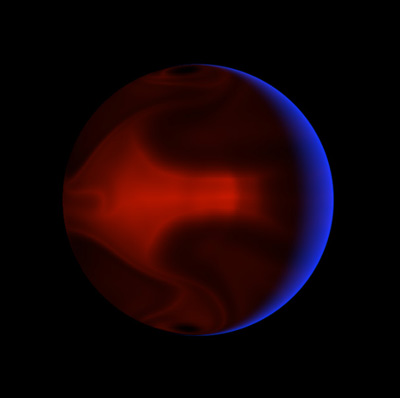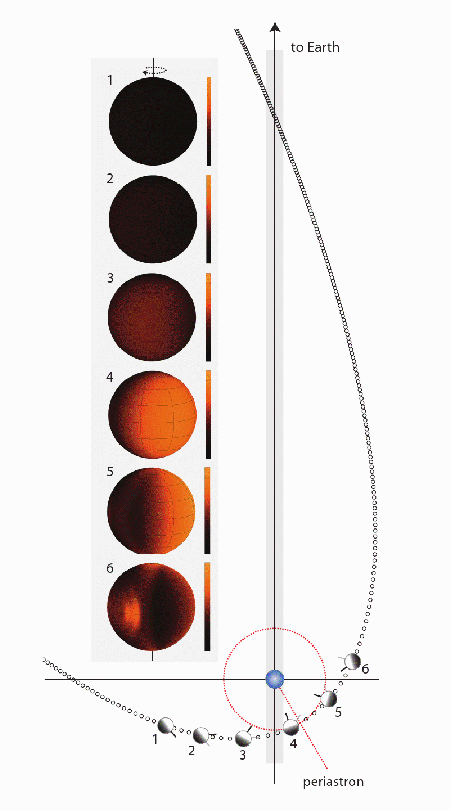I absolutely love the image below, so I decided to run it at full size although it doesn’t quite fit the column width. You’re looking at the result of recent work from the California & Carnegie Planet Search team, which used data from the Spitzer Space Telescope to produce what is probably the most accurate image yet of an exoplanet. It’s not an actual photographic image, of course, but it’s better than an artist’s interpretation because it’s based on highly realistic simulations.
The planet in question is HD 80606b, which circles a star about 200 light years from Earth. This is a highly interesting place, some four times the mass of Jupiter and moving within a 111-day orbit around its star. What makes it stand out is the incredible eccentricity of its orbit. We’re talking about a world that for most of its orbit is at distances that would be between Venus and Earth here in our system. But then it swoops in ever closer to its primary until it closes to within 0.03 AU, an encounter it experiences for less than a day.

Image: The planet HD80606b glows orange from its own heat in this computer-generated image. A massive storm has formed in response to the pulse of heat delivered during the planet’s close swing past its star. The blue crescent is reflected light from the star. Credit: D. Kasen, J. Langton, and G. Laughlin (UCSC).
The Spitzer observations took place during this period of closest approach, when a secondary eclipse (as the planet passed behind the star) allowed precise measurements that the researchers used to peg the temperatures on this world. To describe what happens at perihelion, I turn to Jonathan Langton, a UCSC postdoc, who discussed the matter in this news release. HD 80606b is, as you might imagine, a place of storms that defy the imagination, and planetary shockwaves:
“The initial response could be described as an explosion on the side facing the star,” Langton said. “As the atmosphere heats up and expands, it produces very high winds, on the order of 5 kilometers per second, flowing away from the day side toward the night side. The rotation of the planet causes these winds to curl up into large-scale storm systems that gradually die down as the planet cools over the course of its orbit.”
The image above was developed using software from UCSC’s Daniel Kasen, who tuned it to calculate radiative transfer processes that should catch the color and intensity of light this planet produces. Our friend Greg Laughlin, also at UCSC, calls these “…far more realistic than anything that’s been done before for extrasolar planets.” Up next: A possible transit on February 14, which could produce yet more information about this exotic world. Greg’s systemic site will be the place to watch for that.
Have a look at the orbit of this sizzling place in a figure from the paper that Greg just passed along:

Image: Orbital geometry of the HD 80606b system. The small dots show the position of the planet in its orbit at one hour intervals relative to the predicted periastron passage… The size of the parent star HD 80606 is drawn in correct relative scale to the orbit. Credit: Greg Laughlin.
What a place is HD 80606b. According to the paper on this work, the planet receives 828 times more irradiation at perihelion than at the most distant point in its orbit, with a temperature swing from 800 to 1,500 kelvin in a six hour period! The paper is Laughlin et al., “A Direct Observation of Rapid Heating of an Extrasolar Planet,” Nature 457, (29 January 2009), pp. 562-564 (abstract).


I’ve been at this all day: it’s not “degrees Kelvin” it’s just “kelvin”.
Right you are, Haplo, and I’ve changed it in the text above.
For those curious about this, here’s a snip from the US Metric Association:
Anyone care to explain why it is called just “kelvin” with no
degrees and no capital K?
Seems so trivial in light of this latest find, but I just want to
know. Please don’t just say it’s because some committee
said so.
On the exoplanet itself, I would not be surprised if there are
no smaller worlds near that sun with that monster plowing
through the neighborhood. Maybe farther out, but then they
may be too cold for complex life.
Well it looks like 2009 is opening with a pretty spectacular set of exoplanet-related results… we’ve already had coplanarity determination for Gliese 876, now the results of HD 80606b, and an upcoming CoRoT symposium.
As for the stability of additional planets around HD 80606, this paper indicates that there is a stable region starting at roughly 1.75 AU from the star, but if the eccentric orbit of HD 80606b is due to Kozai cycles induced by the binary star orbit (HD 80607 is the companion star), a multi-planet system would likely have been destroyed as the eccentricities increased.
Because it’s an absolute scale, according to wikipedia: “The omission of “degree” indicates that it is not relative to an arbitrary reference point such as the Celsius and Fahrenheit scales, but rather an absolute unit of measure which can be manipulated algebraically (e.g. multiply by two to indicate twice the amount of “mean energy” available among elementary degrees of freedom of the system).”
Larry
Ok I won’t say it, but that is indeed why. No more reason. Except the “degrees” bit. The kelvin scale is an absolute scale, as is rankin, whereas degrees scales like Celsius and Fahrenheit aren’t from absolute zero but have different zero-points and thus we state them positive and negative relative to their zero points. There is no negative kelvin or rankin, and no relative (degrees) temperatures in K or R.
Maybe we should start by not looking at systems that are so far away? Why arent we looking at our nearest stars and then work our way outwards?
Just a thought.
AAVSO Alert Notice 393
Monitoring for a planetary transit of HD 80606
February 3, 2009
Dr. Greg Laughlin (Lick Observatory) requests intensive time-seriesphotometry of the possible transiting extrasolar planetary system HD80606.
This system, recently in the news due to the extreme temperatures to be found on the planet, is predicted to reachconjunction on or around HJD 2454876.5 (2009 Feb 14.0 UT), and there is a low but significant probability (<15%) that the system is eclipsing.
If it eclipses, the duration of the eclipse may be as long as 17 hours.
Observers are requested to perform high-S/N, filtered photometry of this bright star during a window beginning 48 hours before the predicted eclipse and ending 48 hours after.
Due to the long duration of the eclipse, it is unlikely that a single observer will be able to follow the transit from ingress through egress. Therefore, in order to model the eclipse profile, the data of many observers will need to be combined.
Because the transit is expected to have low amplitude (on the order of 10 mmag), high-precision photometryof HD 80606 is required, and users are *strongly encouraged* to fully calibrate and transform their data and perform an extinction correction prior to submission. Doing so will make the process of combining data from different observers far easier.
The following color data for HD80606 should be used when performing transformations to the standard system: V=9.127 , (B-V)=+0.786 , (V-Rc)=+0.431 , (Rc-Ic)=+0.356 ,(V-Ic)=+0.784
If you do not transform your data, please make sure you include photometry of the uneclipsed star either prior to ingress or after egress, to enable us to detect the eclipse. Without calibration or apre- or post-eclipse measure, we cannot compute an offset for yourphotometry.
For more information on computing transformation coefficients for your telescope, please read the following aavso-photometry post by Tim Crawford from March 2008:
http://www.aavso.org/pipermail/aavso-photometry/2008-March/003382.html
Crawford gives links to two additional papers on CCD coefficients:
http://www.aavso.org/observing/programs/ccd/ccdcoeff.pdf which is an instruction manual for computing them, prepared by Lou Cohen, and http://www.aavso.org/publications/ejaavso/v29n1/35.pdf which is a paper on the differences between transformed and untransformed data by Arne Henden.
We note that by computing your transformation coefficients, you can use them both for these data as well as for all future data you submit to the AAVSO on any star taken with the same telescope, CCD, and filter set.
Because HD 80606 is bright (V = 9.13), care must be taken when performing photometry. Please see
http://www.aavso.org/publications/ccdviews/324.shtml#bright
which is a CCD Views article on bright star photometry for suggestions onhow best to perform accurate photometry.
HD 80606 is located at the following (J2000) coordinates: RA: 09 22 37.5679 , Dec: +50 36 13.397
Charts for HD 80606 may be plotted using VSX:
http://www.aavso.org/observing/charts/vsp/index.html?pickname=HD%2080606
Note that HD 80606 is a close double, and that the star of interest is the western member of the pair. Please submit all data to the AAVSO using the name HD 80606 (AUID 000-BCZ-783).
This AAVSO Alert Notice was prepared by Dr. Matthew Templeton.
——————————————-SUBMIT OBSERVATIONS TO THE AAVSO Information on submitting observations to the AAVSO may be found at: http://www.aavso.org/observing/submit/
ALERT NOTICE ARCHIVE AND SUBSCRIPTION INFORMATION An Alert Notice archive is available at the following
URL: http://www.aavso.org/publications/alerts/
Subscribing and Unsubscribing may be done at the following URL:
http://www.aavso.org/publications/email/
A Dangerous Summer on HD 80606b
Illustration Credit: D. Kasen (et al.UCSC), NASA, JPL-Caltech
Explanation: On the distant planet HD 80606b, summers might be dangerous. Hypothetic life forms floating in HD 080606b’s atmosphere or lurking on one of its (presently hypothetical) moons might fear the 1,500 Kelvin summer heat, which is hot enough not only to melt lead but also nickel.
Although summers are defined for Earth by the daily amount of sunlight, summers on HD 80606b are more greatly influenced by how close the planet gets to its parent star. HD 80606b, about 200 light years distant, has the most elliptical orbit of any planet yet discovered. In comparison to the Solar System, the distance to its parent star would range from outside the orbit of Venus to well inside the orbit of Mercury.
In this sequence, the night side of HD 80606b is computer simulated as it might glow in infrared light in nearly daily intervals as it passed the closest point in its 111-day orbit around its parent star. The simulation is based on infrared data taken in late 2007 by the Spitzer Space Telescope.
http://antwrp.gsfc.nasa.gov/apod/ap090204.html
Judging by the reports over at systemic, it looks like HD 80606b does not transit. Bummer.
Thermosphere and exosphere of Hot-Jupiters
Authors: A. Lecavelier des Etangs
(Submitted on 23 Feb 2009)
Abstract: Here we describe the observations and the resulting constraints on the upper atmosphere (thermosphere and exosphere) of the “Hot-Jupiters”. In particular, observations and theoretical modeling of Hot-Jupiter evaporation are described. The observations allowed the discovery that the planet orbiting HD209458 has an extended atmosphere of escaping hydrogen and showed the presence of oxygen and carbon at very high altitude.
These observations give unique constraints on the escape rate and mechanism in the atmosphere of these planets. The most recent Lyman-alpha HST observations of HD189733b allows for the first time to compare the evaporation from two different planets in different environments.
Models to quantify the escape rate from the measured occultation depths, and an energy diagram to describe the evaporation state of Hot-Jupiters are presented. Using this diagram, it is shown that few already known planets could be remnants of formerly giant planets.
Comments: Invited review at IAU Symposium 253 “Transiting planets”. Pont F., Queloz D., Sasselov., Torres M., and Holman M., Eds
Subjects: Earth and Planetary Astrophysics (astro-ph.EP)
Cite as: arXiv:0902.3938v1 [astro-ph.EP]
Submission history
From: Alain Lecavelier des Etangs [view email]
[v1] Mon, 23 Feb 2009 16:10:15 GMT (550kb)
http://arxiv.org/abs/0902.3938